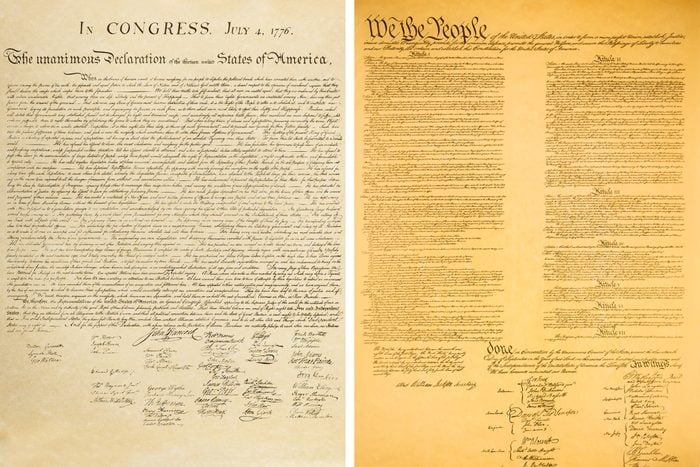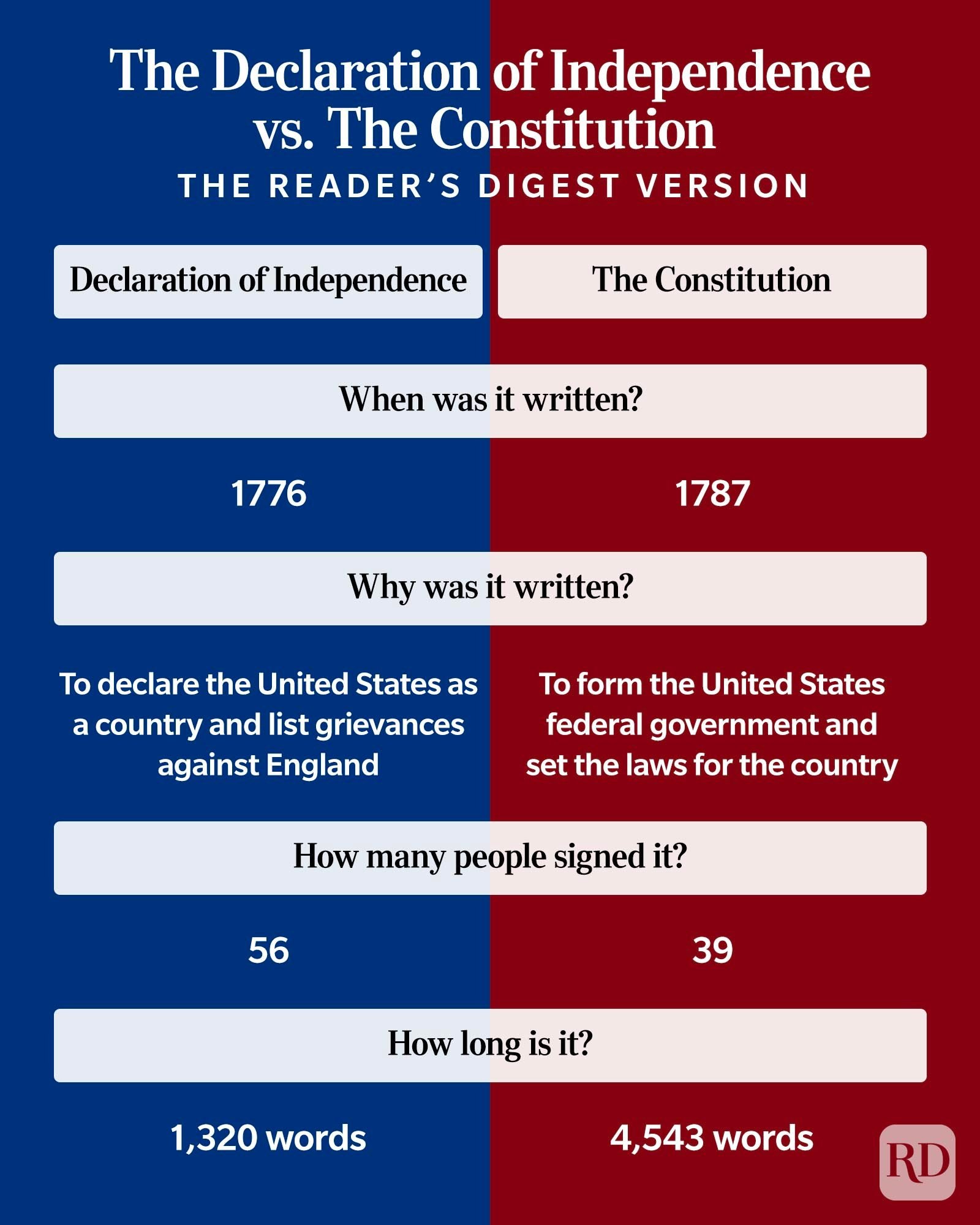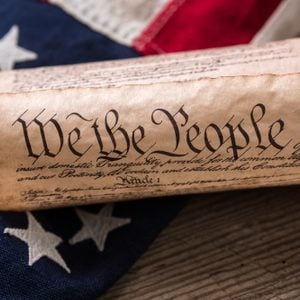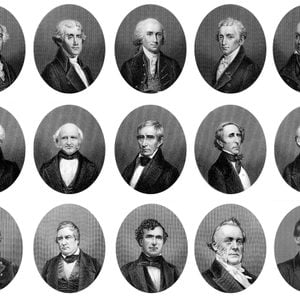The Declaration of Independence vs. The Constitution: What’s the Difference?
Updated: Jan. 17, 2024

It's a common mistake to confuse the Declaration of Independence vs. Constitution—but there are important differences
No matter where you’re from, you’ve surely heard of the important documents that laid the foundation for the birth of America. But when it comes to the Declaration of Independence vs. the Constitution, what’s the difference, actually? We’ve gotten to the bottom of it, and even thrown in some other facts about the Declaration of Independence (and its signatures) and the Constitution. For more on American history, check out this 4th of July trivia and these 4th of July quotes. Plus, what is the 4th of July all about anyway?
What’s the difference between the Declaration of Independence and the Constitution?
In short, the Declaration of Independence states that the United States of America is a country in its own right, independent of England, and includes a list of grievances against the king of England. The difference between the Declaration of Independence vs. the Constitution is that the U.S. Constitution formed our federal government and set the laws of the land. There are no amendments to the Declaration of Independence, but the Constitution originally had 12.

Is the Declaration of Independence older than the U.S. Constitution?
The Declaration of Independence dates back to 1776. The document was finalized on July 4 of that year, though it was not officially signed by representatives from all the 13 colonies until August 2.
The U.S. Constitution wasn’t written until the Constitutional Convention, from May 25 to September 17, 1787.
Who wrote the Declaration of Independence and the U.S. Constitution?
Thomas Jefferson was the principal drafter of the Declaration of Independence and went on to serve as the third president of the United States.
James Madison, who is considered the “Father of the Constitution,” would go on to serve as the fourth president of the United States.
What are the preambles?
The preamble to the Declaration of Independence begins with the famous sentence: “We hold these truths to be self-evident, that all men are created equal, that they are endowed by their Creator with certain unalienable Rights, that among these are Life, Liberty and the pursuit of Happiness.”
The U.S. Constitution begins with “We the people of the United States of America,” which is notable because it shows that the Constitution is “of the people, for the people, and by the people of the United States.” At the time it was written, the idea of a government “for the people” was novel.
Who signed both documents?
One of the most common misconceptions in the Declaration of Independence vs. Constitution confusion is that both the documents were drafted and signed by the same people. Despite the two documents being written just 11 years apart, only six men—George Clymer, Benjamin Franklin, Robert Morris, George Read, Roger Sherman, and James Wilson—signed both. Jefferson was not involved in writing the Constitution and wasn’t even in the United States in 1787 for the Constitutional Convention. At the time, the future third president was serving as the American Minister to France. Did you know that the reason we set off fireworks for Independence Day has to do with the Founding Fathers?
Which document has more signatures?
Declaring independence was a momentous moment but also one fraught with peril for those who put their John Hancock on that document. It was seen as a treasonous act against England. Given that, it’s surprising that there are more signatures on the Declaration of Independence (56) than on the Constitution (39).
Did these documents create equality?
An important similarity in the Declaration of Independence vs. Constitution question is that neither document condemned nor attempted to halt the business of slavery, despite the preamble to the Declaration of Independence stating that “all men are created equal.” Some believe Jefferson meant that phrase to mean all humanity is created equal, and according to Constitution Facts, “Jefferson had originally included language condemning the British promotion of the slave trade,” but that language was later edited out. Jefferson himself was a slave owner, and he was no longer alive when Black Americans became free.
Meanwhile, the Constitution allowed for each slave to count as three-fifths of a person when determining representation in Congress and taxation, in what became known as the “Three-Fifths Compromise.” Smaller, Southern slave-owning states were wary of larger states having too much power in the House of Representatives and argued that slaves should count in some way toward their population counts. Also read about why even hate speech is protected under the U.S. Constitution.
At the time the Declaration of Independence was written, women were not included in the “All men are created equal” statement, either. In addition to not uniformly having the right to vote until the passage of the 19th amendment to the Constitution in 1920 (much later than many other countries), back in 1776, most women were essentially considered the “property” of their fathers or husbands. While you’re on the subject, learn how and why the ERA coalition is fighting for women’s equal rights in the modern world.
How many copies of each were made?
There were about 200 copies of the Declaration of Independence printed by John Dunlap and distributed throughout the colonies. Those precious copies are now known as “Dunlap Broadsides”—they are super rare and now worth a fortune. It’s thought that only 25 of these copies still exist. The next time you’re at a yard sale, keep your eyes peeled, because a few decades ago one lucky shopper unknowingly purchased a previously unknown Dunlap Broadside for $4 at a flea market and sold it for $2.4 million in 1991.
The Constitution, on the other hand, was only written down once, although 14 copies of the Bill of Rights were produced, one for each of the original 13 states and one for the federal government to keep.
Where are the Declaration of Independence and U.S. Constitution today?
Visit the Rotunda for the Charters of Freedom housed inside The National Archives in Washington D.C. to see the original Constitution, a copy of one of the original Declarations of Independence and a copy of the original Bill of Rights, including the 12th proposed amendment that was not ratified. Next, learn about the glaring grammar mistakes in the U.S. Constitution.
Sources:
- National Constitution Center: “Constitution FAQs”
- Constitution Facts: “James Madison, Father of the U.S. Constitution”
- Constitution Laws: “Importance of We the People”
- Library of Congress: “Creating the Declaration of Independence”
- Constitution Facts: “Fascinating Facts about the Declaration of Independence”
- National Constitution Center: “The Three-Fifths Compromise”
- New York Times: “Declaration of Independence Sells for $2.4 Million”
- National Constitution Center: “Bill of Rights FAQs”



